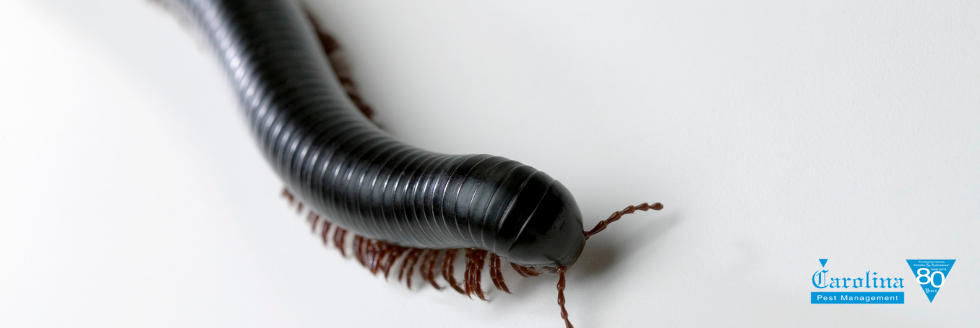How to Get Rid of Millipedes
If you’ve spotted a swarm of millipedes in your home, the sight can be more than a little unnerving. Because of the millipede’s shape, it can look more like a snake or a worm at first. Once you realize that it has hundreds of little legs, that doesn’t make the discovery any better.

Fortunately, unlike their main contemporary counterpart, the centipede, millipedes are mostly harmless to humans and our environments. Even so, having an infestation can be off-putting. So, it helps to know why these pests are in your home and how to get rid of them.
What is a Millipede?
At first, you might think that millipedes are just extra-long insects. However, insects all have six legs, and since millipedes have far more, they’re part of a different animal class altogether. In fact, this species is more closely related to aquatic arthropods like shrimp and lobster than any terrestrial insect.
While the name millipede means “a thousand legs,” none of the 7,000 millipede species have that many legs. Instead, the number ranges from about 40 to several hundred. However, because each segment of a millipede’s body has two pairs of legs, the animal looks like it has way more than it should. Most millipedes can grow between 2.5 centimeters to 13 centimeters long.
Where Do Millipedes Live?
You can find millipedes across the United States, as they live in all 50 states and Puerto Rico. There are about 1,400 different species in the U.S. and Canada, meaning they can adapt to a wide range of climates and environments.
That said, millipedes like to congregate in warm, damp places where they can find a lot of food and shelter from predators. Unlike centipedes, millipedes don’t have a way to defend themselves from other creatures. Instead, they rely on their hard exoskeleton for protection.
What Do Millipedes Eat?
All millipede species feed on decaying organic matter, such as rotting leaves and soil. Usually, you can find millipedes in gardens, and they are often much more helpful than harmful. If there is an abundance of millipedes in a given area, they may take to eating plant seedlings or other material like rotting wood.
Are Millipedes Dangerous?
No, millipedes are relatively harmless to humans and pets. Some species may emit a toxic substance from their exoskeleton to ward off predators. If you touch one of these millipedes, you might notice a slight burning sensation or skin irritation, but nothing serious. Although millipedes have mouths to eat their food, they don’t bite.
Signs of a Millipede Infestation
Because these animals only eat decaying matter, you generally won’t notice any signs of them in your home. Typically, the only way you’ll know that millipedes are inside is if you happen to spot them. For example, if you’re cleaning out your basement, you might find a clump of millipedes behind some old boxes or furniture, provided that the area is warm and damp.
How to Get Rid of and Prevent Millipedes in Your Charlotte Home
Fortunately, millipede infestations are pretty easy to control. Follow these methods for a millipede-free home:
- Keep a Dry Interior – Millipedes need humidity to thrive, so if you use dehumidifiers in your home, you can drive them out.
- Remove Dead Plants and Wood – If food is abundant in your home, it can attract millipedes (and other pests). Clean out and remove any decaying matter that may look delicious to a millipede.
- Call the Experts – If millipedes have already claimed a spot in your home, it can be tricky to try and remove them yourself. Instead, call professional pest control experts to ensure that all of the bugs are cleared out. From there, the pros can identify potential entry points and seal them to prevent future invasions.
Contact Carolina Pest for Your Millipede Needs!
Even though you don’t have to worry about millipedes destroying property or hurting you and your family, they can be a nuisance. At Carolina Pest, we’ve handled plenty of millipede infestations, so we can come in and remove the pests quickly and safely. Since they’re so beneficial to the local ecosystem, we can even transport them outside instead of exterminating them. Contact us today to set up an appointment and consultation.
FAQs About Millipedes
Can a millipede hurt you?
No, millipedes don’t bite, although some species may secrete a toxic substance that can irritate the skin.
What’s the difference between a millipede and a centipede?
There are a couple of defining differences between these species. Millipedes have two pairs of legs per segment, while centipedes only have one leg on each side. Centipedes also have large pincers that they use to hunt and defend themselves. Millipede pincers are much smaller and almost impossible to see.
What happens if a millipede bites you?
It’s rare for a millipede to bite, but even if it does, the animal’s pincers are likely not large enough to break the skin.
Do millipedes lay eggs in houses?
Millipedes lay their eggs in the soil and other decomposing materials. So, if your basement or crawlspace has dirt, it can act as a breeding ground for new millipede eggs.
